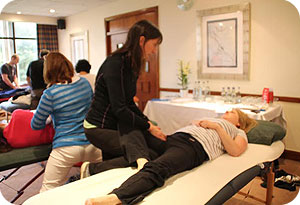 On the weekend of the 16th and 17th of May, Hendrickson Method Practitioners and those embarking on the work, all of whom have attend an Introduction to the Hendrickson Method gathered.
On the weekend of the 16th and 17th of May, Hendrickson Method Practitioners and those embarking on the work, all of whom have attend an Introduction to the Hendrickson Method gathered.
Led by myself, we spent the weekend investigating the psoas and reviewing past treatment protocols. The conclusion was that they often fell short. However we felt that the Hendrickson Method gives the precision that is needed, with depth and gentleness promoting the feeling that we are working with the patients rather than at the patient.
What we needed was to expand our knowledge. We spent time considering the relationship between biceps femoris and the gluteal group, and how it can influence psoas at its full range of function along with the role of the pelvic muscles and how we need balance within the pelvic floor in order to stand tall and walk. These muscle need to be in perfect balance for the body to make small subtle shift in weight. As Eric Franklin points out in ‘Dynamic Alignment Through Imagery 2nd Edition (Human Kinetics) ‘The pelvic floor relates functionally to the thoracic diaphragm, iliopsoas, transverse abdominis, rectus abdominis, oblique abdominis, and lumber multifidus.’ As he explains I develop an increasing vivid picture of how the psoas feeds through the pelvic area on to the lesser trochanter. We also went on to examine how the adductors, piriformis, and the other deep lateral rotators could influence the function of the psoas if they were not long, strong, and operating at their full range.
Next we investigated the role of muscle in their role as prime mover, antagonist, synergist, enquiring what would occur if they are not fulfilling their role. The range of movement becomes restricted and if left unaddressed patterns of dysfunction can set in with the patient not even being aware.
It was also an opportunity for therapist to review their knowledge and experience of the Hendrickson Method soft tissue mobilisation, and wave mobilisation®. We took time to assess our precision, depth, gentleness, and checking in on our intent through the movement with ourselves. As a group we reflected on how there are no new strokes just the deepening of our knowledge and touch.
It was beneficial to spend some time reviewing the execution of Mets, looking at making the contraction very very small, to isolate out a ‘certain’ muscle to create a for the want of a better word ’purer’ ‘clearer’ reconnection neurologically . All the time checking in with our intention, exploring how we keep focus, sharing in an open and honest way what can get in the way, bringing in our humour, having a smile at ourselves. At the same time considering how can we re-engage our patients with their bodies. We practiced describing anatomy, creating pictures, imagine the pelvic floor as a ‘hammock’ with candy stripes, and some fun sharing feedback, all of which reflected how unique we all are.
Toward to end of the weekend we practiced some of the ‘Imagery’ movements based on Eric Franklin work to help patients reconnect with good function in the muscles, this also acts as ‘homework’ without it feeling like exercise. In my experience within my practice this is working much more successfully than standard rehab exercise.
At the start of the weekend I asked the group to notice how they were standing, noticing femurs, feet, lower back, knees. As the weekend drew to a close we took time, at the closing circle to note any change as we had all been working on each other. The feedback was good showing clear evidence based practice, as each therapist could identify change. The feedback was they felt taller, straighter, more grounded, more into their heels, being able to feel a ‘letting’ going in the hamstrings.
I shared that I believe I am on a great adventure, always discovering something new in how the body functions, moves, and the courageous part for me is my developing understanding of the neurological system/function which will aid me in enabling those patients in chronic pain.
This is a super quote from Theodore Rosevelt,
‘It is not the critic who counts; not the man who points out how the strong man stumbles, or where the door of deeds could have done them better.
The credit belongs to the man who is actually in the arena, whose face is marred by dust and sweat and blood; who strives valiantly; who errs, who comes short again and again, because there is no effort without error and short-coming; but who does actually strive to do the deeds; who knows great enthusiasms, the great devotions; who spends himself in a worthy cause;
who at the best knows in the end of triumph of high achievement, and who at the worst, if he fails, at least fails while daring greatly……’
